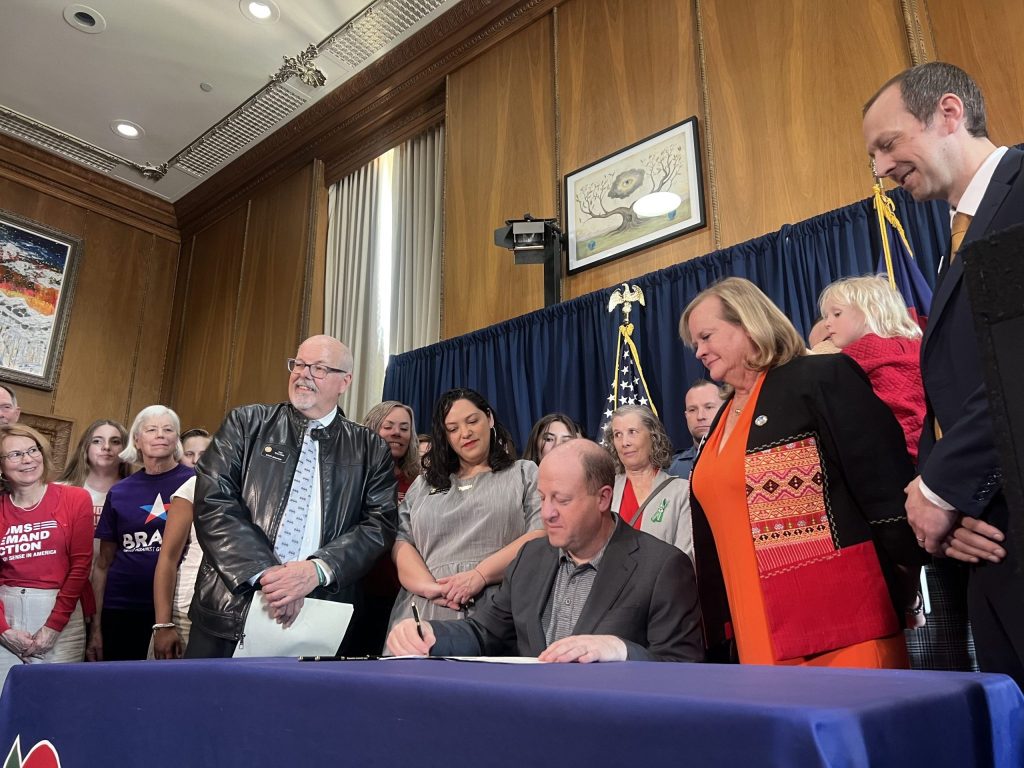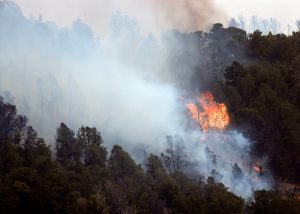Colorado sheriffs say new gun control law will strain resources on the Western Slope
Starting next August, Senate Bill 3 will place significant new restrictions on who can buy certain semiautomatic guns, like AR-15s and AK-47s

Andrew Maciejewski/Summit Daily News
Sheriffs in Colorado’s resource-stretched mountain communities are far from enthusiastic about being on the front lines of implementing the state legislature’s sweeping gun control law next year.
Senate Bill 3 places new vetting and training requirements on Coloradans who want to own semiautomatic guns that accept detachable magazines, such as AK- and AR-style rifles and pistols. It was signed into law this spring and is set to take effect in August 2026.
The law creates a multistep process for gun purchasers that includes a background check, permit application, and hours of safety training. Legislators, who had to close a $1.2 billion deficit in the state’s budget this year, did not allocate any new funding to help local officials with the rollout.
The Post Independent reached out to sheriffs in several Western Slope counties to hear about how the new law could impact their operations and whether they feel prepared. In emailed responses, some said they may need to cut programs or seek additional taxpayer funding to support the initiative, even as some of their counties face potentially severe budget shortfalls.
Summit County Sheriff Jaime FitzSimons said SB 3 imposes “unfunded mandates that require significant time, personnel and financial resources to implement.”
“These include the expansion of firearms safety programs and outreach efforts that were not previously within the scope — or budget — of many sheriff’s offices, particularly in rural or resource-limited counties like Summit,” FitzSimons said.
Moffat County Sheriff Chip McIntyre described his office as one with “a lean staff and a budget focused on core public safety services, including patrol, detention and emergency response.”
“Adding a new statutory obligation, especially one that requires verification processes, applicant communication, and documentation, could divert staff time from these primary functions,” he said. “Without additional support, it may delay other services or strain operational efficiency.”
Under SB 3, sheriff’s offices will be tasked with running background checks and issuing permits to people to enroll in a gun safety course. They’ll also need to identify and vet qualified firearms instructors who will administer the course and will have to enter applicants’ information into a state-run database.
Courses will range from four hours for applicants who already hold a hunter’s license to 12 hours for those without a license. Applicants will need to take a test at the end to purchase an otherwise illegal gun, and they’ll be required to renew their permit every five years for future purchases.
Colorado Parks and Wildlife will be in charge of developing both the course criteria and curriculum, as well as the database. SB 3 does authorize the wildlife agency to use $1.4 million from its Parks and Outdoor Recreation Cash Fund this year to help with initial operational costs.
But as Parks and Wildlife Law Enforcement Chief Ty Petersburg put it, “To say money was allocated is a bit of a misnomer. We’re essentially borrowing our own money.”
Roughly $1 million from the cash fund is slated to go to developing and maintaining the state database. Petersburg said this will be used by multiple entities, including sheriff’s offices, private safety instructors and gun retailers, who will use it to ensure that would-be gun purchasers are meeting all of the criteria.
The remaining $400,000 will be used to hire additional staff, like a program manager, a specialist who can work with independent trainers, and IT and administrative support.
Petersburg said that money “is not there to help offset the sheriff’s costs, and it would probably have to be a far larger number to offset their expenditures.”

Sheriffs will be able to charge a fee when people apply for a permit to take the course, with some of those funds meant to help cover their costs for administering the program. Funds will also go to Parks and Wildlife to pay back its $1.4 million implementation costs, with the hope being that fee revenue can become a sustainable funding source for the future.
That will be in addition to whatever rate private firearm instructors charge.
Sheriffs said it’s difficult to know what their fee structure should be, however, as it will be subject to demand. The state anticipates that there could be around 50,000 gun applicants each year.
Several sheriffs said they will likely need to hire at least one new full-time employee, potentially more, to carry out their duties come next summer.
Eagle County Sheriff James van Beek said that may mean his office pursues additional county funding, cuts to other programs, or a mix of both.
Garfield County Sheriff Lou Vallario said his county faces a “grim” budget outlook that will make hiring additional staff a challenge. The county currently has a temporary hiring freeze in effect for all administrative positions as local leaders look to close what they believe to be a $9 million budget shortfall.
Vallario said this “may cause us to eliminate important positions and programs, like we had to do in 2021 with our animal control program.”
Similar budget issues are plaguing other resort counties, including Summit, which is projecting ongoing multi-million-dollar deficits through 2029. Along with the financial burdens, SB 3 puts sheriffs in the crossfire of an intense political debate over gun control and Second Amendment rights, potentially exacerbating tension between some local law enforcement and the state.
While FitzSimons, a Democrat, said the law was “well-intentioned,” Vallario, who is a Republican, called it “unconstitutional crap” and a “back-door attempt at gun control.”
Vallario added that the law’s potential budget impacts are an “abuse of our county taxpayers,” which he blamed on “stupid liberal lawmakers.” SB 3 passed on a nearly party-line vote, with almost all Democrats in support and all Republicans opposed.
McIntyre, the Moffat County sheriff, said he has “serious concerns about the state legislature’s continued efforts to infringe upon the Second Amendment rights of law-abiding citizens.”
“SB 3 is just the latest example of legislation that imposes unnecessary barriers on responsible gun ownership,” he said.
Van Beek, the Eagle County sheriff and a Republican, did not wade into his personal feelings on SB 3. He was opposed to previous gun control measures from the state, namely a 2019 “red flag” law that allows family members and law enforcement to petition a judge to allow for firearms to be taken from someone deemed a danger to themselves or others.
Petersburg, the Parks and Wildlife law enforcement chief, acknowledged there were a “significant number of sheriffs” who were opposed to SB 3 for both logistical and political reasons.
Parks and Wildlife did not sponsor SB 3, but it did advocate for hunters and sports shooters as the legislation was being crafted. Petersburg said the agency’s job is “to implement the law, as written.”
Petersburg stressed that successful implementation will come from collaboration and support with sheriffs. While the agency has had some informal discussions with sheriffs, Petersburg said they’re in the hiring process for staff who can begin the outreach and stakeholder effort in earnest.
From those discussions, the state will be able to better understand the needs of sheriffs and how to support them, Petersburg said.
“We need to be lockstep with the sheriffs to be able to pull this off. Political differences and opinions aside, it’s what the law says,” Petersburg said. “Whether it’s a smaller county that’s more conservative-leaning or a liberal county, we all have to pull on the same rope together.”

Support Local Journalism

Support Local Journalism
Readers around Glenwood Springs and Garfield County make the Post Independent’s work possible. Your financial contribution supports our efforts to deliver quality, locally relevant journalism.
Now more than ever, your support is critical to help us keep our community informed about the evolving coronavirus pandemic and the impact it is having locally. Every contribution, however large or small, will make a difference.
Each donation will be used exclusively for the development and creation of increased news coverage.










